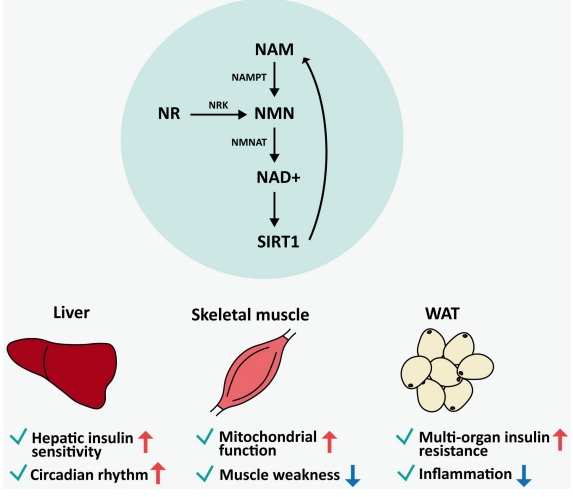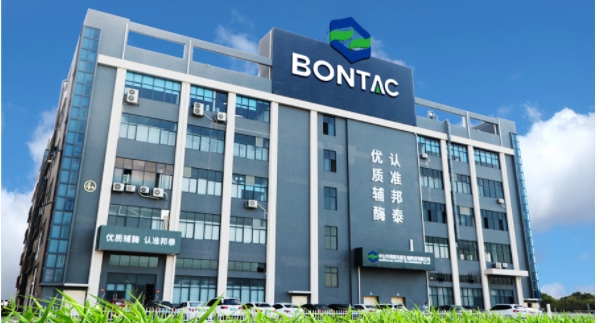
01 Jan
The Importance of NAD Metabolism in White Adipose Tissue

1. Introduction
Nicotinamide adenine dinucleotide (NAD) compartmentalized in adipocytes can modulate adipocyte differentiation and gene expression, in addition to controlling glucose metabolism. White adipose tissue (WAT), one major adipose tissue, may be one of the direct target for NAD supplementation.
2. About WAT
In contrast to brown adipose tissue (BAT), WAT contains a single lipid droplet and few mitochondria. WAT, once thought to be morphologically and functionally unremarkable, is in fact highly dynamic, with plasticity and heterogeneity, which is widely distributed in the subcutaneous tissues and around the internal organs. WAT plays a key role in a range of biological processes, such as maintenance of energetic homeostasis, processing and handling of glycans and lipids, blood pressure control, and host defence, with tight relationship with metabolic disorders such as diabetes.
3. The tissue-specific roles of NAD
NMN is synthesized from NAM and NR by NAMPT and NRK, respectively. The synthesized NAD+ from NMN is used as a SIRT1 substrate, which leads to the recycling of NAD+ via the salvage pathway. In this process, NAD+ can exert different effects depending on the tissue. Remarkably, NAD precursors can control metabolic stress particularly via focusing on adipose tissue.


4. The effects of boosting NAD+ on WAT
Supplementation of NMN and NR has been shown to reduce body weight and enhance insulin sensitivity in regular chow-fed aged wild-type mice and diet-induced obese mice, respectively. NAM supplementation diminishes fat accumulation in diet-induced obese mice. Additionally, both NMN and NR supplementation prevent inflammation even with different treatment duration. NAM administration boosts mitochondrial biogenesis and glutathione synthesis in WAT. Similarly, it is evidenced that NMN treatment in high fat diet-induced type 2 diabetes mouse model facilitates the recovery of Glutathione S-transferase Alpha 2 (Gsta2) gene expression in the liver.


5. The adipose-specific effects of nicotinamide phosphoribosyltransferase (NAMPT)
NAMPT, one NAD regulator in WAT, is a promising therapeutic target for the treatment of metabolic disorders. NAMPT plays a potential role in maintaining adipose tissue homoeostasis, as evidenced by the explicitly blocked adipocyte differentiation and lipid synthesis in vitro post treatment of NAMPT inhibitor FK866.
For some reasons such as differences in sex, age, and/or basal levels of cellular NAD+ availability, there are various inconclusive results regarding the impacts of NAD+ metabolism on adipocytes in the adipocyte-specific NAMPT-deficient mouse model or in vitro cell models. Further investigation on the effects of NAD+ supplementation and the distinct functions of NAMPT in adipocytes is still needed.

For some reasons such as differences in sex, age, and/or basal levels of cellular NAD+ availability, there are various inconclusive results regarding the impacts of NAD+ metabolism on adipocytes in the adipocyte-specific NAMPT-deficient mouse model or in vitro cell models. Further investigation on the effects of NAD+ supplementation and the distinct functions of NAMPT in adipocytes is still needed.

6. Conclusion
The importance of NAD metabolism in WAT has been highlighted. NAD has tissue-specific roles. Specifically, WAT may be one of the direct target for NAD supplementation. Supplementation with NAD+ precursors can reduce fat accumulation and inflammation in adipose tissue.
Reference
Kwon SY, Park YJ. Function of NAD metabolism in white adipose tissue: lessons from mouse models. Adipocyte. 2024;13(1):2313297. doi:10.1080/21623945.2024.2313297
About BONTAC
BONTAC has been dedicated to the R&D, manufacture and sale of raw materials for coenzyme and natural products since 2012, with self-owned factories, over 170 global patents as well as strong R&D team consisting of Doctors and Masters. BONTAC has rich R&D experience and advanced technology in the biosynthesis of NAD and its precursors (eg. NMN and NR), with various forms to be selected (eg. endoxin-free IVD-grade NAD, Na-free or Na-containing NAD; NR-CL or NR-Malate). High quality and stable supply of products can be better ensured here with the exclusive Bonpure seven-step purification technology and Bonzyme Whole-enzymatic method.


Disclaimer
This article is based on the reference in the academic journal. The relevant information is provide for sharing and learning purposes only, and does not represent any medical advice purposes. If there is any infringement, please contact the author for deletion. The views expressed in this article do not represent the position of BONTAC.
Under no circumstances will BONTAC be held responsible or liable in any way for any claims, damages, losses, expenses, costs or liabilities whatsoever (including, without limitation, any direct or indirect damages for loss of profits, business interruption or loss of information) resulting or arising directly or indirectly from your reliance on the information and material on this website.
Under no circumstances will BONTAC be held responsible or liable in any way for any claims, damages, losses, expenses, costs or liabilities whatsoever (including, without limitation, any direct or indirect damages for loss of profits, business interruption or loss of information) resulting or arising directly or indirectly from your reliance on the information and material on this website.
